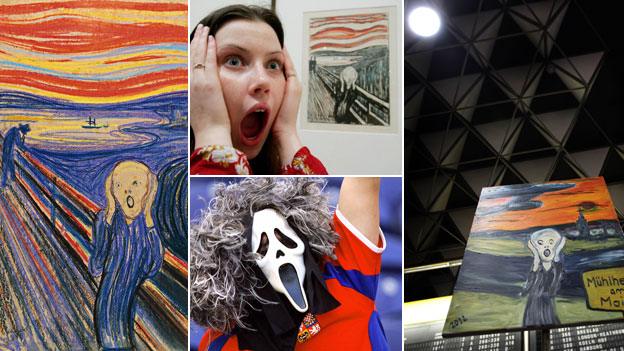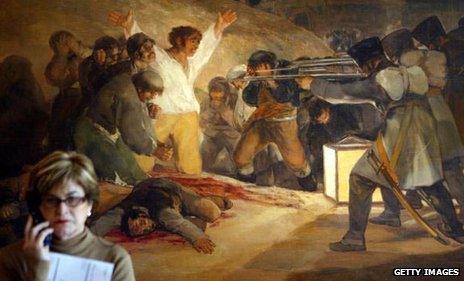Munch's The Scream... and the appeal of anguished art
- Published
- comments

Edvard Munch's masterpiece The Scream is expected to fetch record sums at auction. Why are such agonised, visceral works of art so highly sought-after?
Under a swirling, blood-red sky, a lone figure on a bridge clasps its head in its hands and cries out in despair.
It's a tortured, chaotic portrait of hopelessness and anxiety - hardly the kind of sight you might expect to adorn countless mugs, calendars and posters in homes around the world.
And yet somehow The Scream, Edvard Munch's deeply personal channelling of his own tormented psyche, has become one of modern art's most familiar images - not to mention the target of several high-profile thefts.
When his pastel-on-board version goes to auction in New York in May - he made four - it is expected to fetch £50m ($80m), making it one of the most expensive artworks in the world.
But while The Scream's fame is undeniable, its ubiquity and widespread popularity are, at least on the surface, more difficult to explain.
An icon of misery and desperation makes for an unlikely decorative addition to the typical living room wall, after all.
Nonetheless, given that endless reproductions have ensured that perhaps only the Mona Lisa is more instantly recognisable, it's difficult to escape the conclusion that the anguish depicted in The Scream is something that millions of people are drawn to seek out.
Of course, it is not only visual art that is capable of producing hugely popular representations of despondency.

Alone again, listening to sad music
Directors such as Ken Loach and David Cronenberg could never have forged lengthy careers if audiences favoured only joyful optimism and spurned bleak, depressing stories.
Nor would great works of literature like Shakespeare's Hamlet and Hardy's Jude the Obscure have proved so enduring.
The entire canon of popular music would be lost without desolation and anguish, a point made by Nick Hornby's narrator in his novel High Fidelity: "People worry about kids playing with guns, and teenagers watching violent videos... Nobody worries about kids listening to thousands - literally thousands - of songs about broken hearts and rejection and pain and misery and loss."
And like a good pop song, The Scream is bright, vivid and instantly recognisable.
According to David Jackson, professor of Russian and Scandinavian art histories at the University of Leeds, these qualities allow people with little knowledge of Expressionist art to relate to what was, when it was first shown, an avant-garde work.
"It's quite cathartic," he says. "It speaks to everybody - we've all felt alone and despairing at some point in our lives.
"I think this compulsion to look at things that trouble us is a fundamental part of the human condition. If you go to WH Smiths or Waterstones you find all these books on sale about abused children. The whole myth and industry around Vincent van Gogh is based on the same thing."
Perhaps for this reason, The Scream's influence on modern art has been considerable, as seen in Francis Bacon's Screaming Popes series, Picasso's Guernica and, of course, Andy Warhol's silk prints of Munch's work.
Popular culture has embraced the iconography, from the mask in Wes Craven's Scream films to the Munch-inspired alien villains The Silence in Doctor Who.
Munch himself was the first to produce this image in bulk, creating four versions - two paintings and two pastels - between 1893 and 1910, as well as a lithograph.
But not all within the art world are pleased by its ubiquity.
Rachel Campbell-Johnston, The Times's chief art critic, is not a fan. The Scream's popularity, she believes, derives from a tendency to regard artforms prefixed with adjectives like "edgy", "dark" and "disturbing" as somehow superior to those which are light and joyful.

The Scream influenced Bacon's Pope paintings
Indeed, she draws an analogy with a teenager listening to overwrought, depressing music in their bedroom, before learning as they grow older to appreciate a songwriter like Bob Dylan who deals with subtler, more complex emotions.
"The Scream is almost childish in its directness," she says. "That's why you see it in so many university halls of residence. What you get out of that painting is not something that deepens over time.
"It appeals to an immature taste. As you get older you want something different - art that transforms the everyday rather than goes to the extremes of human emotion."
What is not in doubt is that the emotions expressed by Munch in his series of Screams were entirely authentic. Haunted by suicidal thoughts and struggling with destitution and family tragedy, the despair portrayed in pastel and paint was the artist's own.
For Sue Prideaux, author of an award-winning biography of Munch, it is impossible to ignore the image's wider context - a widespread late-19th Century sense of unease as the works of Darwin and Nietzsche corroded the old faiths and centuries of previous generations.
It was Munch's ability to blend the deeply personal with the universal that has made his most celebrated work so enduring, she says.
"The feelings expressed in the painting were extremely subjective on Munch's part," she says. "But because this skull, essentially, has an everyman quality we can all project our feelings onto it."
There is evidence to suggest, however, that the widespread attachment to art that conveys feeling of despair and horror is more than simply an aesthetic preference.
Psychologist Dr Eugene McSorley, of the University of Reading, has carried out studies tracking people's eye movements when they are shown unpleasant images - famine victims, people with gunshot wounds, dead bodies.

Artists such as Goya depicted the disasters of war to devastating effect
"It seems very difficult for people to suppress or ignore these images," McSorley says. "They find it very hard not to move their eyes towards them.
"You could speculate that this gives you an evolutionary advantage to spot things which are going to hurt or kill you. Or you might argue that these basic emotions are easier to recognise and process than others that are more complex."
Such a conclusion is fuel for critics who bemoan The Scream's lack of subtlety - and also for fans who celebrate its cathartic universality.
Which ever camp you fall into, that wailing, skeletal figure's hold on the popular imagination remains impregnable.
- Published21 February 2012